HPE6-A84 Online Practice Questions and Answers
Questions 4
You want to use Device Insight tags as conditions within CPPM role mapping or enforcement policy rules.
What guidelines should you follow?
A. Create an HTTP authentication source to the Central API that queries for the tags. To use that source as the type for rule conditions, add it an authorization source for the service in question.
B. Use the Application type for the rule conditions; no extra authorization source is required for services that use policies with these rules.
C. Use the Endpoints Repository type for the rule conditions; Add Endpoints Repository as a secondary authentication source for services that use policies with these rules.
D. Use the Endpoint type for the rule conditions; no extra authorization source is required for services that use policies with these rules.
Questions 5
What is a common characteristic of a beacon between a compromised device and a command and control server?
A. Use of IPv6 addressing instead of IPv4 addressing
B. Lack of encryption
C. Use of less common protocols such as SNAP
D. Periodic transmission of small, identically sized packets
Questions 6
Refer to the scenario.
A customer requires these rights for clients in the "medical-mobile" AOS firewall role on Aruba Mobility Controllers (MCs):
1.
Permitted to receive IP addresses with DHCP
2.
Permitted access to DNS services from 10.8.9.7 and no other server
3.
Permitted access to all subnets in the 10.1.0.0/16 range except denied access to 10.1.12.0/22
4.
Denied access to other 10.0.0.0/8 subnets
5.
Permitted access to the Internet
6.
Denied access to the WLAN for a period of time if they send any SSH traffic
7.
Denied access to the WLAN for a period of time if they send any Telnet traffic
8.
Denied access to all high-risk websites
External devices should not be permitted to initiate sessions with "medical-mobile" clients, only send return traffic.
The exhibits below show the configuration for the role.
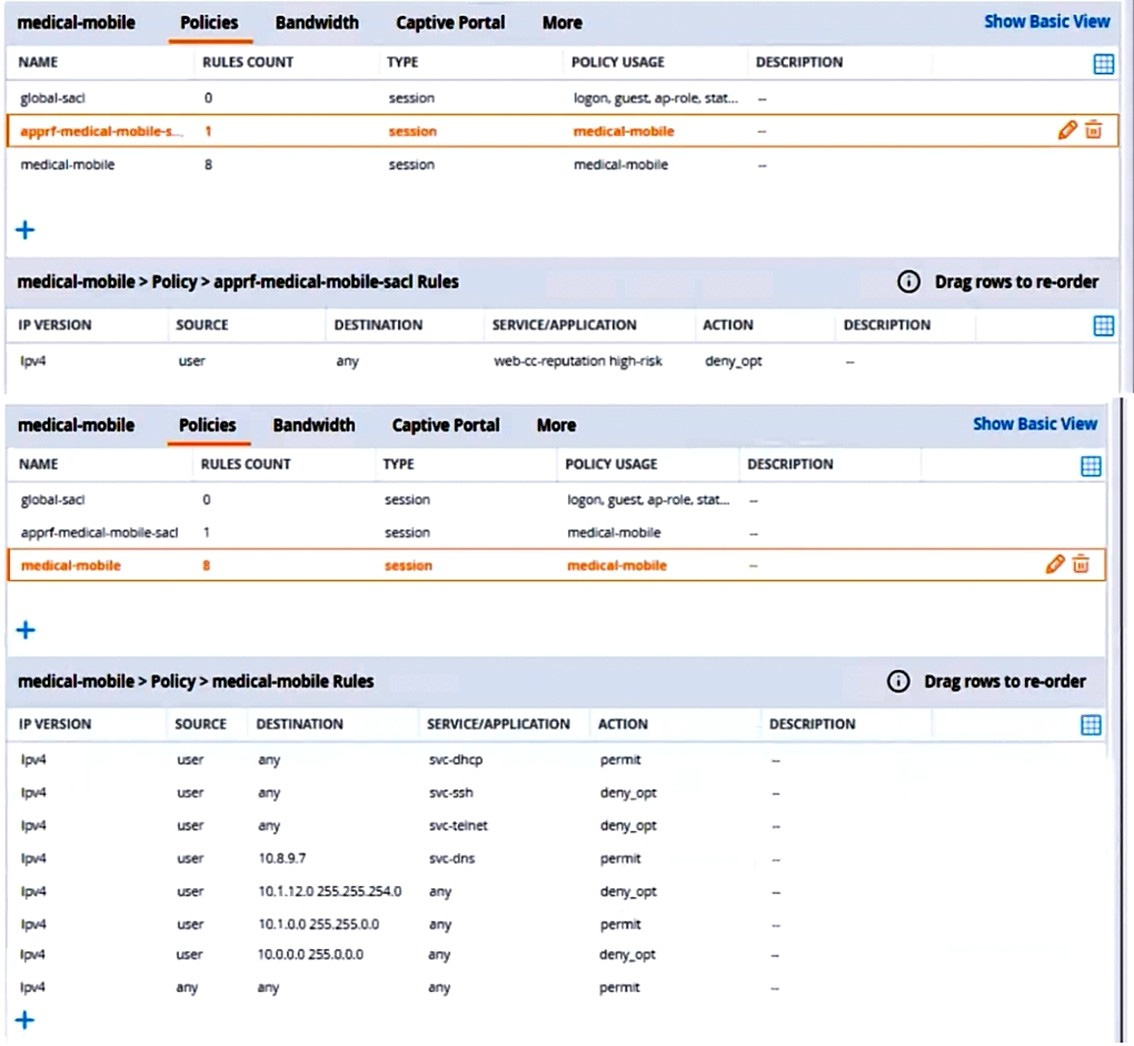
What setting not shown in the exhibit must you check to ensure that the requirements of the scenario are met?
A. That denylisting is enabled globally on the MCs' firewalls
B. That stateful handling of traffic is enabled globally on the MCs' firewalls and on the medical-mobile role.
C. That AppRF and WebCC are enabled globally and on the medical-mobile role
D. That the MCs are assigned RF Protect licenses
Questions 7
Refer to the scenario.
A customer is migrating from on-prem AD to Azure AD as its sole domain solution. The customer also manages both wired and wireless devices with Microsoft Endpoint Manager (Intune).
The customer wants to improve security for the network edge. You are helping the customer design a ClearPass deployment for this purpose. Aruba network devices will authenticate wireless and wired clients to an Aruba ClearPass Policy Manager (CPPM) cluster (which uses version 6.10).
The customer has several requirements for authentication. The clients should only pass EAP-TLS authentication if a query to Azure AD shows that they have accounts in Azure AD. To further refine the clients' privileges, ClearPass also should use information collected by Intune to make access control decisions.
You are planning to use Azure AD as the authentication source in 802.1X services.
What should you make sure that the customer understands is required?
A. An app registration on Azure AD that references the CPPM's FQDN
B. Windows 365 subscriptions
C. CPPM's RADIUS certificate was imported as trusted in the Azure AD directory
D. Azure AD Domain Services
Questions 8
A customer's admins have added RF Protect licenses and enabled WIDS for a customer's AOS 8-based solution. The customer wants to use the built-in capabilities of APs without deploying dedicated air monitors (AMs). Admins tested rogue AP detection by connecting an unauthorized wireless AP to a switch. The rogue AP was not detected even after several hours.
What is one point about which you should ask?
A. Whether APs' switch ports support all the VLANs that are accessible at the edge
B. Whether admins enabled wireless containment
C. Whether admins set at least one radio on each AP to air monitor mode
D. Whether the customer is using non-standard Wi-Fi channels in the deployment
Questions 9
You are setting up Aruba ClearPass Policy Manager (CPPM) to enforce EAP-TLS authentication with Active Directory as the authentication source. The company wants to prevent users with disabled accounts from connecting even if those users still have valid certificates.
As the first part of meeting these criteria, what should you do to enable CPPM to determine where accounts are enabled in AD or not?
A. Add an Endpoint Context Server to the domain controller with actions for querying the domain controller for account status.
B. Enable OCSP in the EAP-TLS authentication method settings and configure an OCSP override to the domain controller FQDN.
C. Add a custom attribute for userAccountControl to the filters in the AD authentication source.
D. Install a Microsoft Active Directory extension in Aruba ClearPass Guest and set up an HTTP authentication source that points to that extension.
Questions 10
You are working with a developer to design a custom NAE script for a customer. You are helping the developer find the correct REST API resource to monitor.
Refer to the exhibit below.
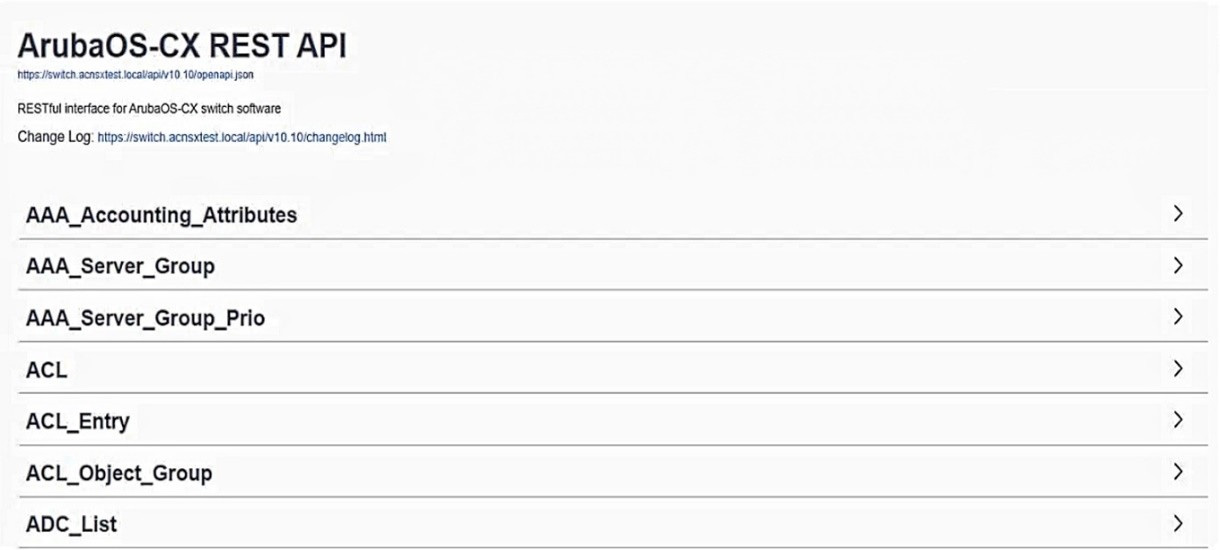
What should you do before proceeding?
A. Go to the v1 API documentation interface instead of the v10.10 interface.
B. Use your Aruba passport account and collect a token to use when trying out API calls.
C. Enable the switch to listen to REST API calls on the default VRF.
D. Make sure that your browser is set up to store authentication tokens and cookies.
Questions 11
Refer to the exhibit.
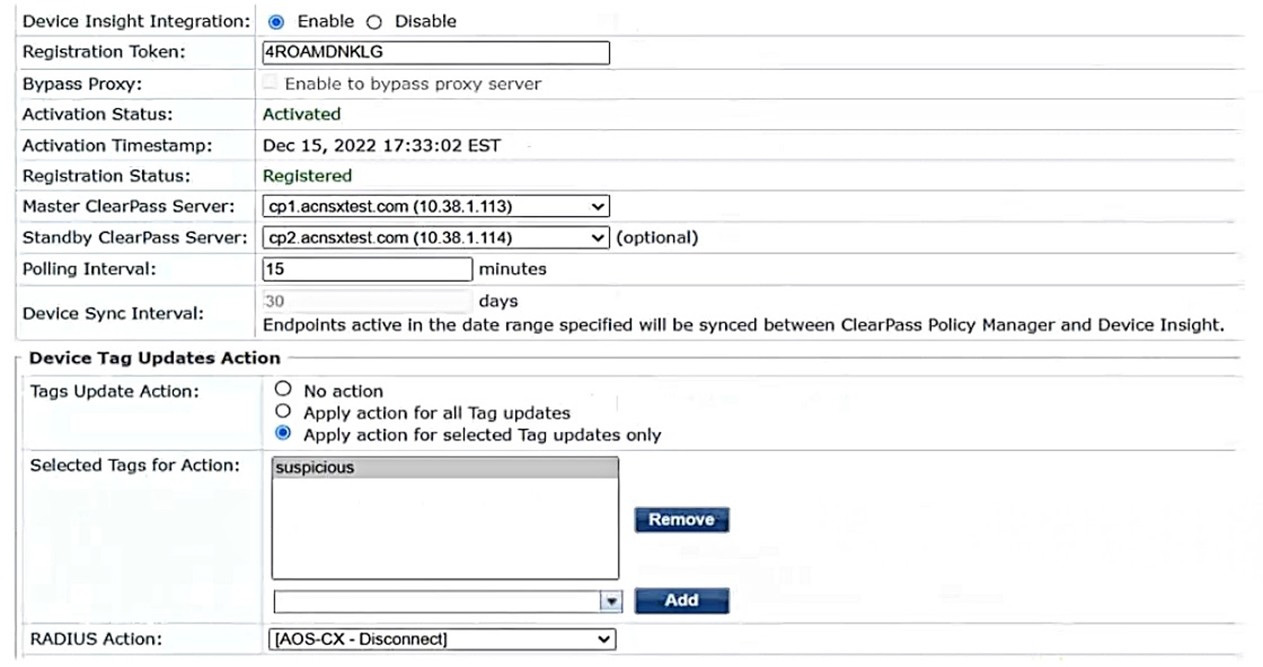
Aruba ClearPass Policy Manager (CPPM) is using the settings shown in the exhibit. You reference the tag shown in the exhibit in enforcement policies related to NASes of several types, including Aruba APs, Aruba gateways, and AOS-CX switches.
What should you do to ensure that clients are reclassified and receive the correct treatment based on the tag?
A. Change the RADIUS action to [Aruba Wireless -Terminate Session] which is supported by all the NASes in question.
B. Change the RADIUS action to [Aruba Wireless - Bounce Switch Port] which is supported by all the NASes in question.
C. Enable profiling in each service using one of these enforcement profiles. Set the profiling action to the correct one for the NASes using that service.
D. Set the Tags Update Action to No Action. Then instead enable the RADIUS CoAs using enforcement profiles in the rules that match clients with the tag shown in the exhibit.
Questions 12
Refer to the exhibit.
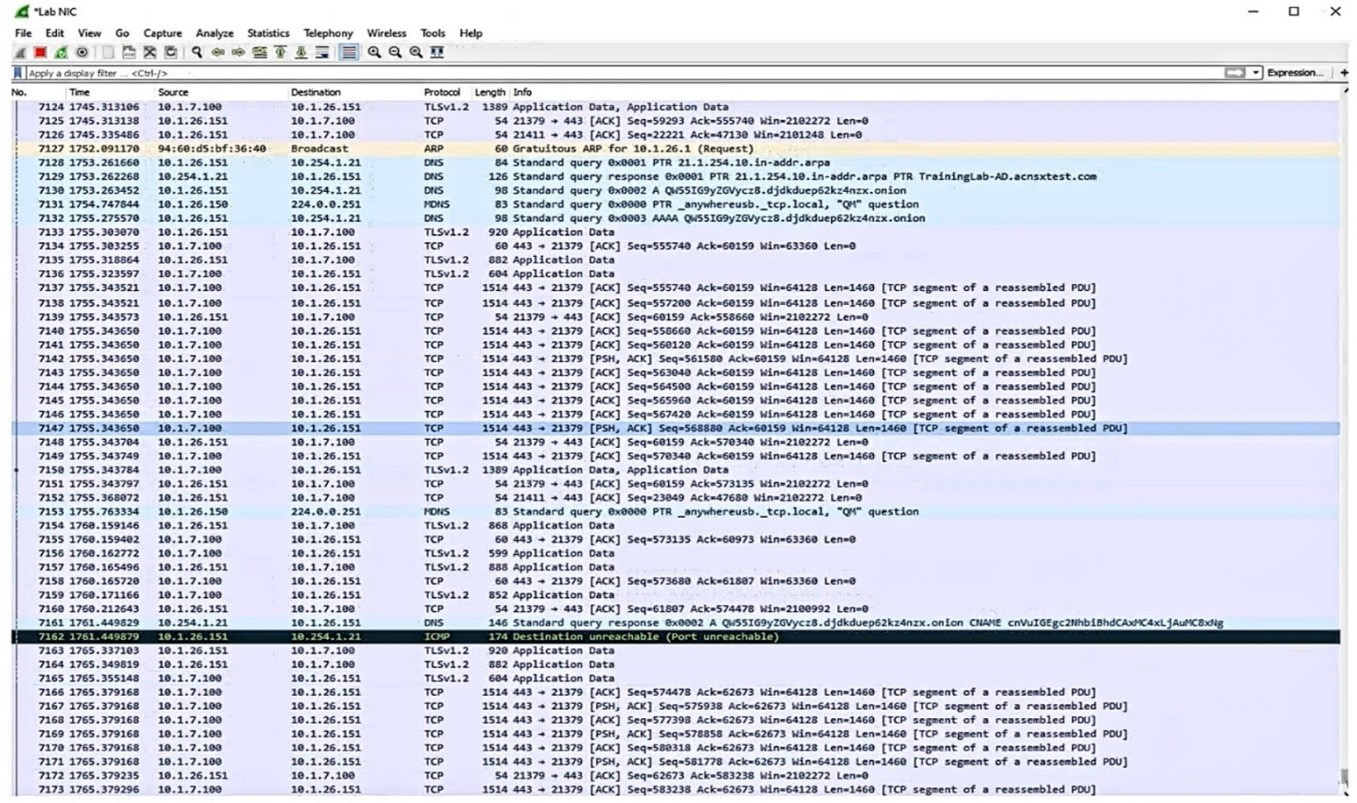
Which IP address should you record as a possibly compromised client?
A. 10.1.26.151
B. 10.1J.100
C. 10.1.26.1
D. 10.254.1.21
Questions 13
Refer to the scenario.
# Introduction to the customer
You are helping a company add Aruba ClearPass to their network, which uses Aruba network infrastructure devices.
The company currently has a Windows domain and Windows CA. The Window CA issues certificates to domain computers, domain users, and servers such as domain controllers. An example of a certificate issued by the Windows CA is
shown here.
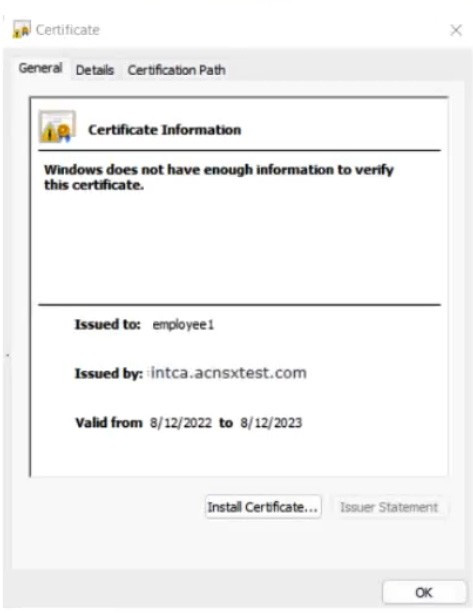

The company is in the process of adding Microsoft Endpoint Manager (Intune) to manage its mobile clients. The customer is maintaining the on-prem AD for now and uses Azure AD Connect to sync with Azure AD.
# Requirements for issuing certificates to mobile clients
The company wants to use ClearPass Onboard to deploy certificates automatically to mobile clients enrolled in Intune. During this process, Onboard should communicate with Azure AD to validate the clients. High availability should also be
provided for this scenario; in other words, clients should be able to get certificates from Subscriber 2 if Subscriber 1 is down.
The Intune admins intend to create certificate profiles that include a UPN SAN with the UPN of the user who enrolled the device.
# Requirements for authenticating clients
The customer requires all types of clients to connect and authenticate on the same corporate SSID.
The company wants CPPM to use these authentication methods:
1.
EAP-TLS to authenticate users on mobile clients registered in Intune
2.
TEAR, with EAP-TLS as the inner method to authenticate Windows domain computers and the users on them To succeed, EAP-TLS (standalone or as a TEAP method) clients must meet these requirements:
1.
Their certificate is valid and is not revoked, as validated by OCSP
2.
The client's username matches an account in AD # Requirements for assigning clients to roles After authentication, the customer wants the CPPM to assign clients to ClearPass roles based on the following rules:
1.
Clients with certificates issued by Onboard are assigned the "mobile-onboarded" role
2.
Clients that have passed TEAP Method 1 are assigned the "domain-computer" role
3.
Clients in the AD group "Medical" are assigned the "medical-staff" role
4.
Clients in the AD group "Reception" are assigned to the "reception-staff" role The customer requires CPPM to assign authenticated clients to AOS firewall roles as follows:
1.
Assign medical staff on mobile-onboarded clients to the "medical-mobile" firewall role
2.
Assign other mobile-onboarded clients to the "mobile-other" firewall role
3.
Assign medical staff on domain computers to the "medical-domain" firewall role
4.
All reception staff on domain computers to the "reception-domain" firewall role
5.
All domain computers with no valid user logged in to the "computer-only" firewall role
6.
Deny other clients access # Other requirements Communications between ClearPass servers and on-prem AD domain controllers must be encrypted. # Network topology For the network infrastructure, this customer has Aruba APs and Aruba gateways, which are managed by Central. APs use tunneled WLANs, which tunnel traffic to the gateway cluster. The customer also has AOS-CX switches that are not
managed by Central at this point.
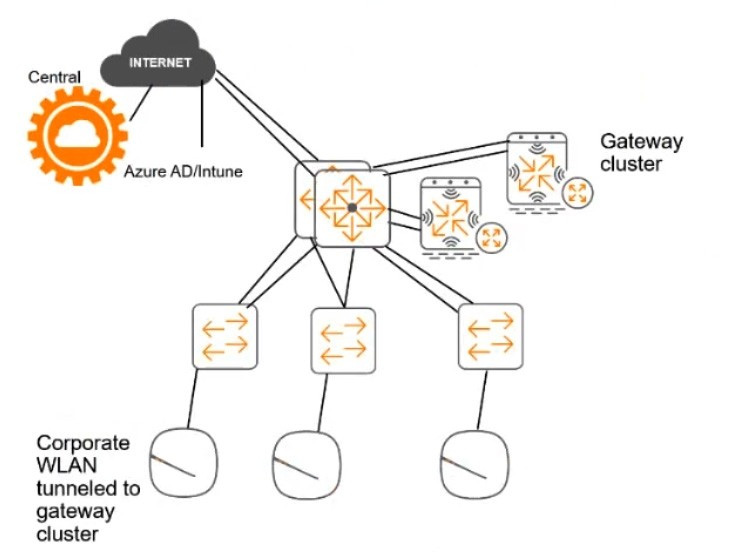
# ClearPass cluster IP addressing and hostnames A customer's ClearPass cluster has these IP addresses:
1.
Publisher = 10.47.47.5
2.
Subscriber 1 = 10.47.47.6
3.
Subscriber 2 = 10.47.47.7
4.
Virtual IP with Subscriber 1 and Subscriber 2 = 10.47.47.8
The customer's DNS server has these entries
1.
cp.acnsxtest.com = 10.47.47.5
2.
cps1.acnsxtest.com = 10.47.47.6
3.
cps2.acnsxtest.com = 10.47.47.7
4.
radius.acnsxtest.com = 10.47.47.8
5.
onboard.acnsxtest.com = 10.47.47.8
The customer has now decided that it needs CPPM to assign certain mobile-onboarded devices to a "nurse-call" AOS user role. These are mobile-onboarded devices that are communicating with IP address 10.1.18.12 using port 4343.
What are the prerequisites for fulfilling this requirement?
A. Setting up traffic classes and role mapping rules within Central's global settings
B. Creating server-based role assignment rules on APs that apply roles to clients based on traffic destinations
C. Creating server-based role assignment rules on gateways that apply roles to clients based on traffic destinations
D. Creating a tag on Central to select the proper destination connection and integrating CPPM with Device Insight
